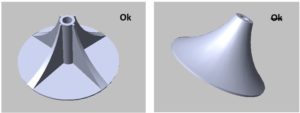3 things to know when designing your part
When designing your plastic or metal part, the ultimate goal is to achieve a technically accurate design that functions well and can be later cost-effectively manufactured. Designing a 3D Part is difficult and crucial. It takes time and patience especially if you’re not very familiar with the software or the technologies, materials or finishing that will be applied to manufacture your end product or prototype. Some parts may also not fit together at the end. From our experience we know that there are several mistakes which can be easily prevented.
Anticipate the plastic or metal material
Every material is different and there are hundreds of plastic or metal materials available with different performances and characteristics. In the early stage of your design you already need to pay attention and understand what material will work best for your application. Materials can be strong, flexible or hard, smooth or rough, heavy or light-weight… More, some materials will be very sensitive to specific chemicals, some other will not. You may also think about the stress that you part will be occurring later, how and in what context it will be used.
For example, if you know you want a part made of metal, there are specific material-related design recommendations that you need to consider, such as supporting overhanging parts, bracing reinforcing elements, rounding corners, etc.

Eventually, you may already think about the cost of the materials, which will directly impact the price of your end-product. In rapid prototyping, we will be able to manufacture you parts at a lower cost, with the right material and functions. You can have a look on our material page.
Anticipate the production of your parts
There are many ways to manufacture your parts from 3D printing or CNC Machining to plastic injection (rapid tooling). This does not mean that you have to be perfectly clear about each technologies but it shall not interfere in later stage. Some materials or finishing could not be processed accurately with all technologies. For example, if you need a small series of functional plastic prototypes, you may need to manufacture a prototype mold for plastic injection. The surface finish then should be specified so it does not interfere with ejection of the part in the mold. Elastic parts cannot be produced by using CNC Machining, as the same for geometrically complex forms. Metal part cannot be produced by using silicon or injection molds. Some technologies will be more cost-effective according to number of parts needed.
In rapid prototyping we will offer several technologies depending on these several factors: the cost, the number of plastic or metal parts you will need, the material and finishing, the application of you part and ultimately its design. For more details on prototyping technologies we invite you to consult our dedicated page.
Anticipate the design of your part
We will not detail of the design requirements and recommendation but we selected two component of the design that deserves paying much attention.
Undercuts
During the conception of your part is it important to consider the presence or not of undercuts. It will have a direct influence on the technology and on the price to produce it. In case your part has undercuts, it maybe is preferable to resort to 3D printing or plastic injection. It is possible to split the part into two pieces, manufacture them separately and glue them together. It can enough for some prototypes made by silicon mold; if you want to produce a highly aesthetic part the glued area will be seen.
 Uniform Wall Thickness
Uniform Wall Thickness
One of the most common reasons for not fitting prototypes would be non-uniform wall thicknesses which will causes dimensional control problems, warpage, and other part integrity issues. It will very crucial especially for plastic injection. A good advice will be to design all part cross-section as thinly and uniformly as possible. Some materials will also require a thicker minimum thickness.

By creating 3D there are several things to consider, Material, Technology and special types of Design are just some of them. But no worries, even if you already have finished your design we can still help you improving and adapting your 3D file in order to make everything fitting.


 We don´t share your data.
We don´t share your data.
